The key to long-term chocolate storage boils down to just two things: heat & water. While chocolate can't go bad, for the most part, it can taste markedly less good.
The best way to store chocolate is in cool ambient temperatures to keep it from developing fat bloom or melting, and in dry locations to keep it from interacting with water and developing sugar bloom or seizing.
There are a variety of chocolate products on the market, from solid bars or bonbons with fillings to creamy fudges and other candies, each of which pose their own storage challenges. Preventing fat and sugar chocolate bloom is essential to effectively storing chocolate long term, and can be achieved by following a few key guidelines.
These can be summarized as follows: store chocolate at ambient temperatures between 58-70°F (15-21°C) with a humidity level of 70% or less. Keep reading to learn more about how long chocolate lasts and our expert tips for long term chocolate storage.

Jump to:
- ❓ How Long Does Chocolate Last?
- 🍫 Chocolate Storage Chart
- 🌟 How Temperature Affects Chocolate
- 👨🏻🍳 Tips for Long-Term Chocolate Storage
- ✔️ How to Store Homemade Chocolates
- 😋 Should Chocolate Be Refrigerated?
- 🧊 Can You Freeze Chocolate?
- ☀️ Storing Chocolate During the Summer
- 🙋🏻♂️ Chocolate Storage FAQ
- 💬 Comments
❓ How Long Does Chocolate Last?
Chocolate usually comes with a best-before date. This serves as a general guideline, set by the manufacturers, of the date until which they can guarantee the best taste and texture of their chocolate.
In reality, chocolate has a long shelf life that actually goes considerably further than what is printed on the best before date— as long as they are stored under the recommendations here.
- Dark Chocolate – can maintain its quality 2 years from the manufacturing date in proper ambient storage conditions, and up to 4 years refrigerated with some degradation.
- White Chocolate – can maintain its quality up to 1 year from its manufacturing date in proper ambient storage conditions, and up to 2 years refrigerated with some degradation.
- Milk chocolate – like white chocolate, it will maintain its quality for up to 1 year in proper ambient storage conditions, and up to 2 years refrigerated with some degradation.
- Bonbons, Fudge, & Others – chocolates with added ingredients like fillings, nuts, dairy, dried fruits, salts, etc., will have varying shelf lives. For these types of chocolates, it's best to follow the label and consume them by the best-before date indicated, or two weeks after the production date.
You’ll note that solid bars experience only slight degradation past their best before dates, because they contain fewer perishable ingredients. On the other hand, it's better to eat chocolate with fillings and other mixed perishable ingredients within two weeks of their production or by their best before date.
To aid in your decision-making, below we look at the characteristics of chocolate, to better understand the recommended temperature and humidity ranges for chocolate storage.
🍫 Chocolate Storage Chart
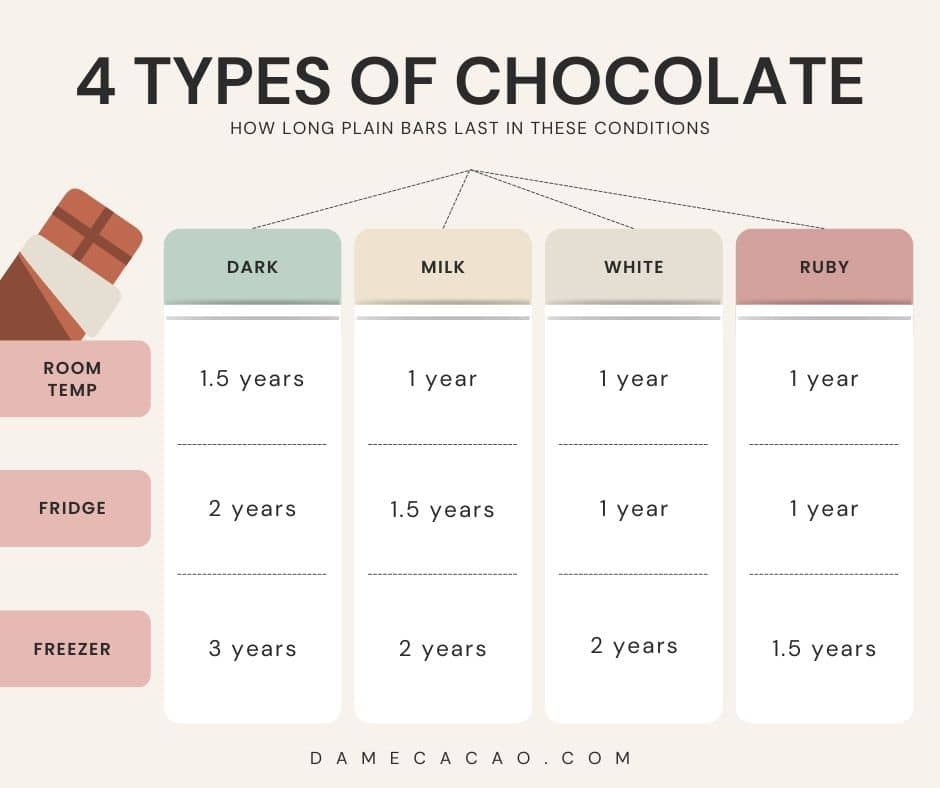
🌟 How Temperature Affects Chocolate
Let's first look at tempering, a process wherein the formation of specific fat crystals in the chocolate give it durability and integrity to hold its shape. More specifically, the cocoa butter (fat) in chocolate is what’s known as a ‘polymorphic substance.’ This means that it can crystalize into six different forms, from I to VI.
This process is very important to chocolate storage, as it provides the optimal structure for chocolate to stay in the shapes into which it is molded. The tempering process involves heating chocolate to a certain temperature, cooling it to another specific temperature, then heating it again to a slightly higher specific temperature.
The form of the resulting crystals depends on the final temperature in the process. This is why failing to control the temperature during this process often leads to random crystal formations, which negatively affect the chocolate's texture and durability.
Aiming to mostly form type V crystals offer chocolate makers and chocolatiers the most shelf-stable chocolates. Type V crystals have the best appearance, snap, and relatively high melting point (around 34°C to 37°C (93.2°F - 98.6°F).
The proper tempering process leaves almost exclusively Type V crystals, with a higher proportion of Type V resulting in a more shelf-stable chocolate, and more flexibility in chocolate storage temperature. Further heating should be avoided in order to prevent other crystal types from forming.
This gathering of properly-formed Type V crystals can now be used as seed crystals, or ‘seed chocolate,’ that serves to model the proper crystal structure for the untempered chocolate to which it’s added.
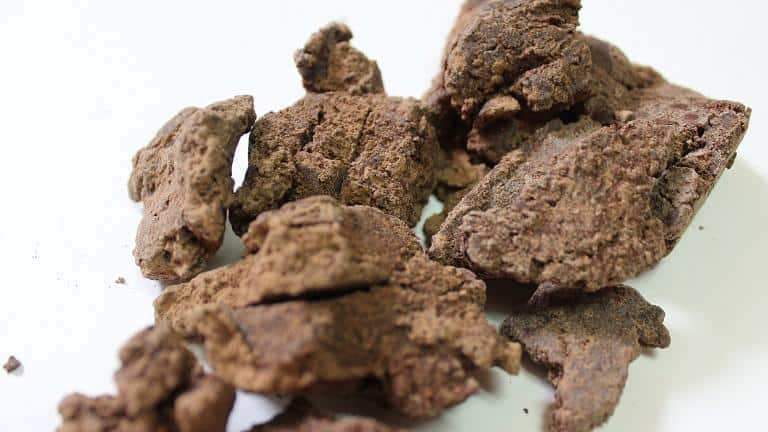
From here the heat tolerance of each chocolate type becomes clearer. Exposure of plain chocolate to direct sunlight & heat beyond the crystal formation's threshold results in their breakdown and the cocoa butter's separation.
This separation initially manifests as off-white or light brownish surface discoloration, which is referred to as fat bloom. As exposure to temperatures closer to human body temperature are reached, the chocolate eventually melts.
One experiment showed that the color of chocolate also determined how quickly it melted. During the trials, dark chocolates always melted the quickest between milk and white chocolates, because its dark color always absorbed more sunlight.
As shown, placing chocolate in an environment below 23°C (73.4°F), where cocoa butter solidifies, and avoiding exposure to direct sunlight promote the preservation of the ever-important Type V crystals.
This prevents the formation of fat bloom and keeps chocolate from melting. But what about the opposite? In the lower half of this temperature range, we now need to look at cold shocks and the effect of moisture on chocolate.

How Temperature Shocks Affect Chocolate
If heat can do a number on chocolate, so can the cold! Moving chocolate to and from cold places exposes it to extreme temperature changes referred to as ‘temperature shocks.’ When this happens, condensation can occur and introduce moisture and water to chocolate.
Dark chocolate absorbs moisture at a humidity level above 82%, and milk chocolate at 78%. From here we can already see that the recommendation for humidity levels of 70% and below is a good allowance for these thresholds. This is because water and chocolate do not mix well, literally.
Sugar in the chocolate is attracted to water, forming sugar crystals when it evaporates, resulting in a white rough grainy surface called sugar bloom. For melted chocolate, exposure to water can cause masses of cacao solids to form and separate due to friction, resulting in clumps that do not blend well.
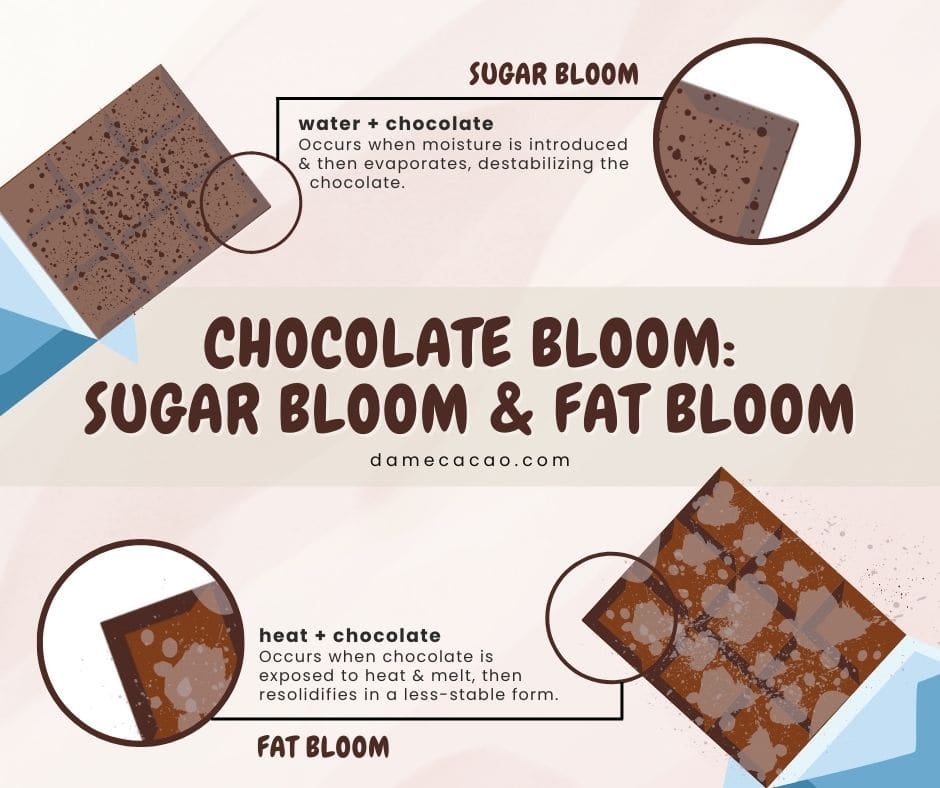
👨🏻🍳 Tips for Long-Term Chocolate Storage
1 – Take note of the kind of chocolate you are storing and the best before date or date of manufacture. For solid bars the best before date is important, and the type of chocolate will dictate exactly how long you can store them.
Chocolate confections and those with mixed ingredients or fillings are quicker to expire, and should be consumed within two weeks of production.
2 – Store chocolate within the proper temperature range. Chocolate melts close to body temperature, and thus needs to be stored at a cool ambient temperature. If your environment allows it, ideally you should store chocolate between 15°C to 21°C (58°F - 70°F) to keep the cocoa butter‘s Type V crystal structures intact.
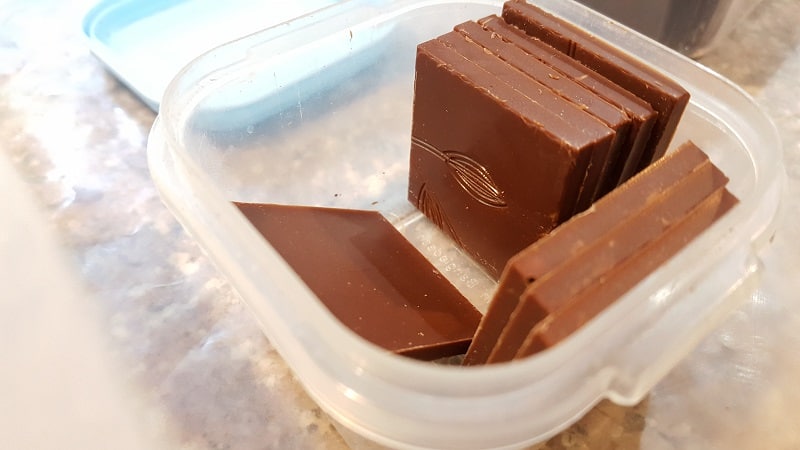
3 – Maintain chocolate's factory packaging unless you plan to eat it soon. It goes without saying that you should not open chocolate packaging unless you plan to eat it, so this goes for whole chocolate products you haven’t tried yet.
A study was actually done that demonstrated that chocolates that were stored in their original packaging between 25°C to 40°C (77°F - 104°F) exhibited lower peroxide values (level of deterioration).
That same study showed that opened chocolates exhibited the greatest moisture gain. If the packaging is broken or none is available, steps need to be taken to seal the chocolate from contamination that could affect structure and flavor.
4 – Protect chocolate from pests. Sometimes even new packaging is not enough to keep them out. A study on insect infestation showed that even aluminum foil was not strong enough to protect fully against attacks from insects, including those pesky ants.
Defensive chocolate storage is necessary, though insects’ and rodents' attacks on milk and white chocolates, as well as chocolate confections with fillings, are higher compared to dark chocolates where cocoa content is higher.
Chocolates that have their packaging breached by or exposed to pests are no longer safe to eat or reuse.
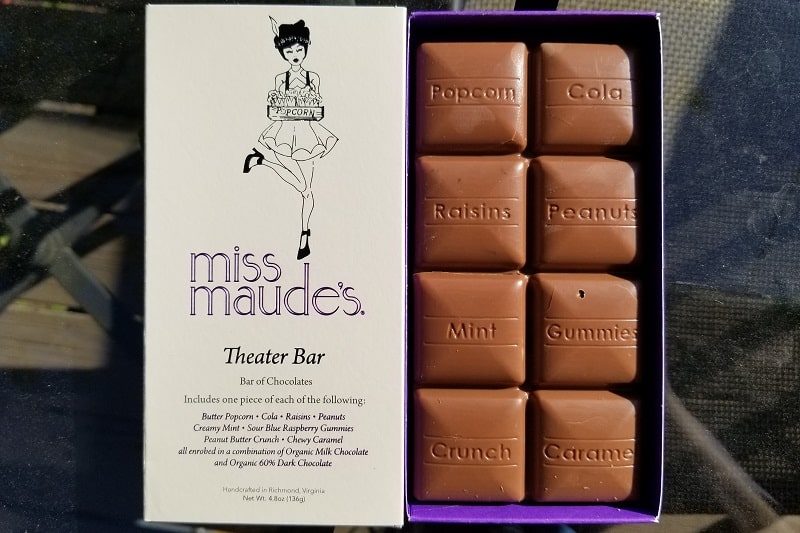
5 – Do not expose chocolate to strong odors or smells. Raw cocoa beans are sensitive to picking up odors, such as smoke from the kiln that might have been used to dry them.
Chocolate is the same way, and care must be taken to keep it from absorbing strong, foul-smelling odors and developing off-flavors. Once chocolate picks up undesirable odors they cannot be removed anymore, even if they are remelted.
6 – Keep chocolate away from direct sunlight or heat-emitting light. In the same study mentioned in tip 3, exposure to heated light sources accelerated the breakdown of free fatty acids that contribute to rancidity (through the oxidation of cocoa butter’s oleic acids).
The development of unpleasant tastes and odors in chocolate is directly attributed to oxidative rancidity. Heat-sealed laminated packaging did well to slow down the acid breakdown, but keeping chocolate away from sunlight and other heated light sources also keeps it from melting.
7 – Be mindful of moisture and humidity. We've already discussed the detriments of water causing sugar bloom and seizing, but to add to this, lipid oxidation is the main cause of spoilage and off-flavor formation in chocolate.
Higher levels of oxidation were found to coincide with chocolate that had absorbed more moisture from rising humidity. This is evidenced clearly in white chocolate, hence why the humidity levels are not to surpass 70% (though lower is always better).
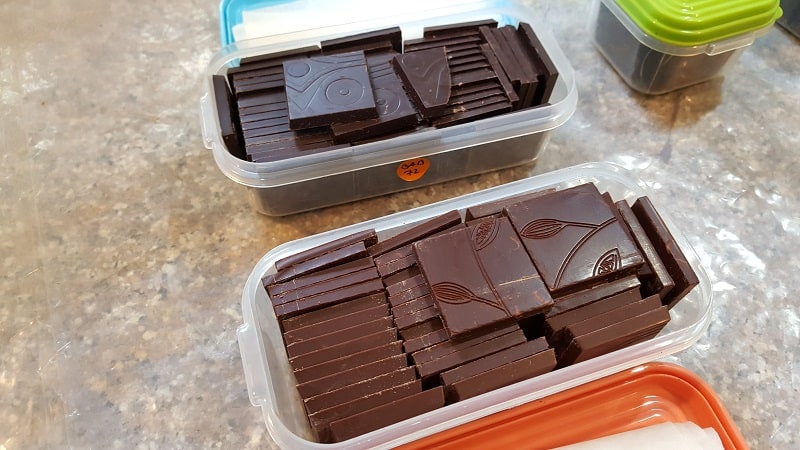
✔️ How to Store Homemade Chocolates
All the previous recommendations apply to homemade chocolate and bonbons as well. Recommendations for homemade bars are unchanged, and will include all the other considerations such as cocoa and cocoa butter content, fillings, and added perishable ingredients.
Chocolate bonbons are slightly different. One chocolatier recommends more care for the storage of chocolate bonbons, because their fillings can contain perishable ingredients and moisture that can grow mold or yeast.
Because of this, it is recommended to store bonbons at a slightly cooler temperature range of 11-18°C (50-65°F), so as to not ruin their texture. A humidity midpoint of 50% to 60% is preferred to keep the moisture in the ganache inside from drying out and creating cracks in the outer chocolate shell.
Fat bloom can also develop if fats from the fillings or nuts happen to penetrate the chocolate layer. The fillings and added perishable ingredients in chocolate bonbons contribute to their incredibly short shelf life.
They should be consumed no longer than a few days from production if properly stored at room temperature, to a maximum of two weeks if refrigerated or frozen properly. Homemade chocolates and bonbons may lack sufficient packaging for long-term storage.
If the ambient conditions are not ideal, a pantry might not be enough. The best kinds of storage are the kind that can control both temperature and humidity levels, like specialized wine cabinets, though those can get expensive. Air-tight storage containers are a must, though vacuum sealing would be ideal.

😋 Should Chocolate Be Refrigerated?
Cadbury advises against refrigerating chocolate, and we’re in agreement. It's best to store chocolate protected from pests in ambient temperatures less than 21°C (69.8°F), humidity levels below 70%, and away from direct sunlight.
If ambient temperatures are higher than what is recommended or if you live in a tropical environment where ambient temperatures are high, keeping them in the fridge can be a good option.
🧊 Can You Freeze Chocolate?
Yes, chocolates can be frozen for long-term storage. You can double the shelf life of chocolate when wrapped air-tight in the freezer, but it will eventually taste less good.
Note that I say frozen chocolate will taste less good, not bad, and that's because putting chocolate in the freezer will damage some of its texture and aromatic qualities.
When defrosting, simply leave it in the fridge first to allow it to adjust to higher temperatures, minimizing greyish sugar bloom from temperature-related condensation.

☀️ Storing Chocolate During the Summer
Temperatures may rise higher than ideal during the summer, or even year-round if you live in the tropics. The thing to keep in mind here is that rapid temperature changes can cause water to form from condensation, leading to dissolves sugars, and eventually to ugly sugar bloom.
Because of this, even though a cooler environment is better, it is also more at risk of moisture during transfers. But if you don't have access to expensive and fancy storage solutions, storing your chocolate in the refrigerator might be your only cost-effective option.
To safely store chocolate in the refrigerator, place it in an air-tight container to slow down oxidation and help prevent odor contamination. This is especially true for those who store ripe fruits, garlic, and other foods with strong flavors in their fridge.
Consider wrapping the chocolate in something that can absorb moisture, such as a paper towel. This way the wrapper can absorb the moisture of the condensation that usually forms when moving chocolate into different environments.

🙋🏻♂️ Chocolate Storage FAQ
Between the fridge and the freezer, it's better to keep chocolate in the fridge for freshness. The temperature difference for chocolate to adjust to is smaller, which is easier to manage than thawing before eating. Storing chocolate in the freezer can also lead to freezer burn that can dull the taste and texture, especially if it contains fillings.
Chocolate confections, with their mix of perishable ingredients, are best consumed by their best before dates, usually just a few months from the time of production. Chocolate bonbons, with fudge/ganache fillings, maintain their taste and texture for only a few days and have the risk of quickly spoiling due to their moisture content.
Dark chocolate stays fresh up to two years from production, if stored in ideal ambient temperatures and conditions (with its original packaging intact). Milk and white chocolates that still have sealed packaging can stay fresh up to one year from the time of their production, but if their packaging has already been opened, they can only last 6 more months.
You can keep plain chocolate in the fridge for up to two years. Though it may come out of temper during that time, losing a bit of flavor and texture, it will still be safe to eat. Just rmemeber to store it in an air-tight container, to avoid it absorbing other flavors in the fridge.

















Comments
No Comments